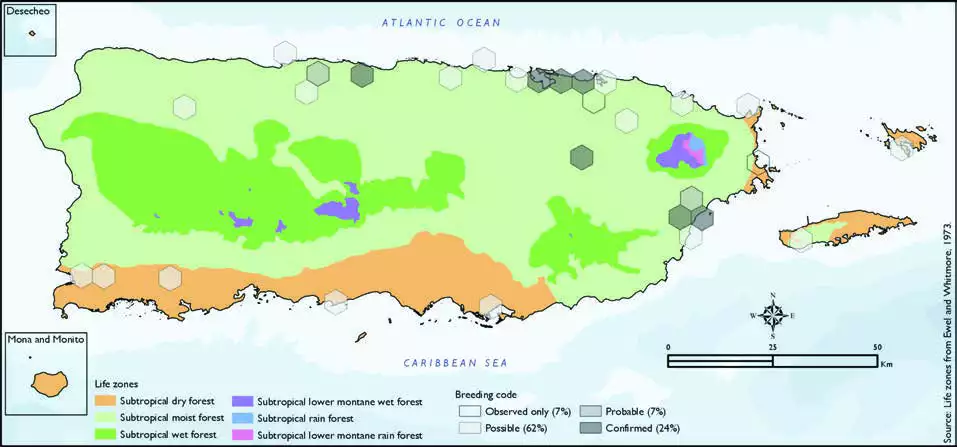Least Bittern
Description
The least bittern (Ixobrychus exilis) is a small heron, the smallest member of the family Ardeidae found in the Americas.
Distribution & Habitat
The Least Bittern occurs from North America through Central
and South America including the
West Indies (Raffaele and others
1998), where it is an uncommon
to locally common resident in
Puerto Rico (J.A. Salguero-Faría,
personal observation 2009). It is
regularly seen at the Humacao
Natural Reserve (Oberle 2018).
It is present on Vieques, where
it ranges from rare to extremely
rare (Gemmill 2015), and is also
present on Culebra. It usually
inhabits shallow marshes, pond
edges, mangroves (Oberle 2018), and freshwater swamps with
dense emergent vegetation, often
cattails (Typha spp.) (Raffaele
and others 1998). The atlas
fieldwork yielded a total of 44
records within 29 hexagons or 6
percent of the 479 total hexagons
(see map). Of the 29 hexagons
where this species was found,
breeding met the atlas definition
of confirmed in 24 percent (7)
of the hexagons, probable in 7
percent (2), and possible in 62
percent (18), while the species
was observed in 7 percent (2)
of the hexagons but without
evidence of breeding (see map).Least Bittern distribution. The map shows the highest breeding code by hexagon and overlaying the ecological life zones in
Puerto Rico. Note: percentages may not total 100 due to rounding. 145Least Bittern/Martinetito

Breeding Habits
Previously published reports indicate that the Least Bittern
breeds from May to August
(Raffaele and others 1998).
The nest is usually constructed
above standing water on aquatic
vegetation, and it is made mostly
of twigs, weeds, cattails, and
other swamp plants (Biaggi 1997,
Raffaele and others 1998). Atlas
results suggest that this species
breeds mostly from December
to August with peak breeding
activity in February, March, and
May (see chart). The breeding activity mostly takes place within
the subtropical moist forest life
zone (see chart). Results (see
table and map) show that this
species breeds mostly on the
coastal plain or lowlands within
the subtropical moist forest
life zone (74 percent of the
hexagons) with some evidence
for breeding found in the
subtropical dry forest life zone
(26 percent of the hexagons).
Conservation
The current population trend of the Least Bittern is described as stable (Butcher and Niven
2007). This species is currently
listed as a species of least
concern by the IUCN (BirdLife
International 2016). Locally, this
species is not listed in any of the
threatened categories of PRDNER
and USFWS. In Puerto Rico, the
Least Bittern has a protected
habitat in land of 14 percent or
91 km2 of the total area covered by the hexagons where evidence
of breeding was found for this
species (645 km2).
Related Species
Family:
heron